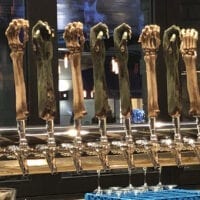
Beer & Books is a semi-regular series featuring thoughts and opinions on books about beer. Imagine that. Oftentimes books mentioned here won’t be new releases. Rather, they’re simply what we’re reading at the time, usually with a cold brew in hand. We rate them on a five-star scale. We’re always looking to add to our library. Please feel free to drop a line if there are Beer Books you recommend we read. Today’s read: Barrel-Aged Stout and Selling Out by Josh Noel.
Barrel-Aged Stout and Selling Out
If you can’t beat ’em, buy ’em. For Anheuser-Busch InBev, the biggest of “big beer,” that’s how it’s built a sizable craft beer portfolio. It started in 2011 with the purchase of Goose Island Brewing Co., which author Josh Noel details in his well-written and thoroughly researched book Barrel-Aged Stout and Selling Out.
 For me, Noel’s book is actually two in one. The first is the story of Goose Island, a family-owned brewery opened in Chicago in 1988. Soon after Goose Island’s sale to Anheuser-Busch, Noel approached John Hall, the brewery’s founder, about telling the Goose Island story in book-length form. (Noel, an accomplished beer journalist for the Chicago Tribune, covered his paper’s backyard craft brewery extensively over the years). As the author mentions in the prologue: “Only one brewery is the story of craft beer: Goose Island.”
For me, Noel’s book is actually two in one. The first is the story of Goose Island, a family-owned brewery opened in Chicago in 1988. Soon after Goose Island’s sale to Anheuser-Busch, Noel approached John Hall, the brewery’s founder, about telling the Goose Island story in book-length form. (Noel, an accomplished beer journalist for the Chicago Tribune, covered his paper’s backyard craft brewery extensively over the years). As the author mentions in the prologue: “Only one brewery is the story of craft beer: Goose Island.”
The book-within-a-book, which sort of happened around Noel as he researched his book, is a balanced commentary on how so-called “big beer” found an opportunity to connect with a market it previously had trouble reaching — craft beer drinkers.
Throughout, Noel provides understandable business analysis and compelling anecdotes culled from dozens of interviews to tie everything together.
Anheuser-Busch Gets Bigger
By one metric, Anheuser-Busch recently became the country’s largest craft beer company (familiar byline), thanks to its pattern of gobbling up one-time independent craft brewers. Of course, technically, its holdings aren’t craft since they don’t comply with the Brewers Association definition of craft brewer.
Still, it’s disheartening to see the trend. Since its purchase of Goose Island seven years ago, Anheuser-Busch went on a buying spree. It purchased nine more craft breweries through 2017. One detail I found fascinating, and hadn’t realized before Noel pointed it out, is the seemingly regional acquisition strategy employed by AB.
A table illustrating the acquisitions shows how AB’s purchases from 2011-17 practically blanketed the United States:
- March 28, 2011: Goose Island Beer Co. (Chicago)
- Feb. 5, 2014: Blue Point Brewing (New York)
- Nov. 5, 2014: 10 Barrel Brewing (Bend, Ore.)
- Jan. 23, 2015: Elysian Brewing (Seattle)
- Sept. 23, 2015: Golden Road Brewing (Los Angeles)
- Dec. 18, 2015: Four Peaks Brewing (Tempe, Ariz.)
- Dec. 22, 2015: Breckenridge Brewing (Littleton, Colo.)
- April 12, 2016: Devils Backbone Brewing (Roseland, Va.)
- Nov. 3, 2016: Karbach Brewing (Houston)
- May 3, 2017: Wicked Weed Brewing (Asheville, N.C.)
The Goose Island Story
While the number of breweries in the U.S. increased dramatically during the AB buying spree — 2,475 in 2012 to 6,372 in 2017, according to the Brewers Association — it also became more difficult to know which craft beers are still technically craft. One takeaway from Barrel-Aged Stout that resonates: Do you know who’s making your beer?
Goose Island, which began as a family-owned brewpub in Chicago, is perhaps most famous for its Bourbon County Stout aged in bourbon barrels, hence the book’s name. The beer became a revelation for beer drinkers used to lighter lagers lining American shelves 25 years ago. In fact, when Hall opened his brewpub, a few years before the introduction of Bourbon County Stout, Noel mentions there were fewer than 200 breweries nationwide.
I found the Goose Island origin story fascinating, if not especially glamorous. You’d think selling more beer than you’re able to produce is a good problem to have. In fact, it was a driver in the sale. The warts-and-all treatment gave a well-rounded view of the business of beer. The author utilized valuable primary sources who could speak authoritatively about Goose Island’s successes and shortcomings.
As a former journalist, I appreciated the journalistic approach Noel took in telling the story. At times I rooted for Goose Island. Then, a few pages later I found myself rooting against it. Same for Anheuser-Busch, if you can believe it (primarily where InBev, the Belgian company that owns AB, is involved). I read somewhere that Barrel-Aged Stout is an interesting David vs. Goliath book, where David ultimately succumbs.
Winners? Losers?
But in the battle between Anheuser-Busch and craft beer, who really is the winner? And who is the loser? Noel suggests looking at it two ways.
“Craft beer won: it forced the biggest beer company in the world to change,” he writes. Or, “Craft beer lost: it had been commandeered by the biggest beer company in the world.”
Either way, Barrel-Aged Stout and Selling Out is a fascinating read. Craft-beer enthusiasts and beer history buffs will find a lot to like in this book.
Beer Books: Barrel-Aged Stout and Selling Out

Book Title: Barrel-Aged Stout and Selling Out: Goose Island, Anheuser Busch, and How Craft Beer Became Big Business
Book Description: From Amazon: "Goose Island opened as a family-owned Chicago brewpub in the late 1980s, and it soon became one of the most inventive breweries in the world. In the golden age of light, bland and cheap beers, John Hall and his son Greg brought European flavors to America. With distribution in two dozen states, two brewpubs and status as one of the 20 biggest breweries in the United States, Goose Island became an American success story and was a champion of craft beer. Then, on March 28, 2011, the Halls sold the brewery to Anheuser-Busch InBev, maker of Budweiser, the least craft-like beer imaginable. The sale forced the industry to reckon with craft beer’s mainstream appeal and a popularity few envisioned. Josh Noel broke the news of the sale in the Chicago Tribune, and he covered the resulting backlash from Chicagoans and beer fanatics across the country as the discussion escalated into an intellectual craft beer war. Anheuser-Busch has since bought nine other craft breweries, and from among the outcry rises a question that Noel addresses through personal anecdotes from industry leaders: how should a brewery grow?"
Book Author: Josh Noel
Book Format: Paperback
Date published: 2018-06-01
ISBN: 1613737211
Number Of Pages: 400
- Utah Beer News Rating
Summary
I sped through the Audible version of Barrel-Aged Stout and Selling Out and liked it so much I purchased the paperback so I could go back and make notes, highlight passages, etc. It’s an extremely well-written and well-researched book detailing not only the Goose Island history, but also the ripple effect its sale (as the first significant “craft” purchase by Anheuser-Busch) seemed to have on the craft beer industry.
Craft-beer enthusiasts and beer history buffs will find a lot to like in this book. As a seasoned beer journalist, Josh Noel does an exceptional job of writing a balanced account. All sides, it seemed, were represented fairly. It’s interesting that Noel first approached John Hall not long after the sale about writing a book-length history of Goose Island. And then, in the seven years that followed, nine more “craft” purchases by AB-InBev helped the book become a much richer, broader view of the overall beer landscape. As craft breweries now exceed 6,000, yet it’s sometimes difficult to determine what exactly is a “craft brewery,” I think the post-sale commentary and analysis regarding the question: Do you know who brews your beer? is just as fascinating as the life story of Goose Island pre-AB-InBev.


